| page last updated |
 |
River Tour | Estuary | Salt Marsh | |
| What is an Estuary? > Climate > Geology > Surface Water > Ground Water > Aquatic Habitat > Upland Habitat > Ecological Processes > Animals and Plants > Socioeconomic Values > Human Impacts and Pollution > Where does Your water come from? > Management Issues > Protecting YOUR Watershed | ||
|
K-12
Students Site
|
||
| Habitat > Aquatic > Upland > Riparian Zones > Plants and Animals | |||||||||||
|
A habitat is an area where an organism lives. An organism finds food, shelter, and everything else it needs to live within its habitat. Upland habitat is the dry habitat along the sides of a river. As you move outward from the river, the habitat changes. The dry habitat zone closest to the sides of a river is called the riparian zone. Beyond the riparian zone, different types of forests grow. The riparian zone is the first upland habitat zone you encounter as you move outward from a river. A healthy riparian zone is characterized by dense vegetation. Shrubs, vines, grasses and trees grow in a healthy riparian zone. Sometimes there is a smooth transition between the marshes on the sides of a river and the riparian zone. The width of a riparian zone varies. The riparian zone along the sides of the Altamaha River is thick with vegetation. As you walk into the riparian zone from the river's edge, it becomes dark and cool. Tree cover blocks the sky, and shrubs and grasses cover the ground at your feet. Endless vines wrap around the shrubs and trees, creating a natural maze. Can you make it through? The plants in a riparian zone are diverse. Common trees include river birch, laurel oak, southern red oak, post oak, willow, red maple, sycamore, locust, hickory, red cedar, cypress, and sweet gum. Once you go beyond the riparian zone of the Altamaha River, different types of forest occur if land has not been altered by human development. Two main types of forests are found beyond the riparian zone of the Altamaha River: bottomland hardwood forests and mixed pine forests. Hardwood trees, such as hickory, red maple, sweet gum, and many species of oak trees, characterize bottomland hardwood forests. Mixed pine forests include many types of pine, such as loblolly pine and long-leaf pine, and hardwood trees. Mixed pine forests usually grow in areas of slightly higher elevation. The Moody Forest is an area along the Altamaha River, protected by The Nature Conservancy, which contains both bottomland hardwood and long-leaf pine habitats. |
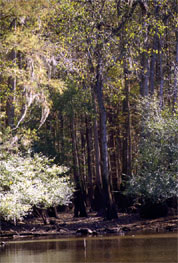 |
||||||||||
| For a larger view of a riparian zone, click on the picture | |||||||||||
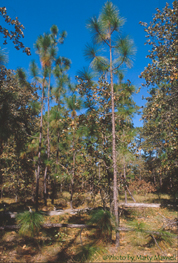 |
|||||||||||
| For a larger view of a young long-leaf pine, click on the picture. | |||||||||||
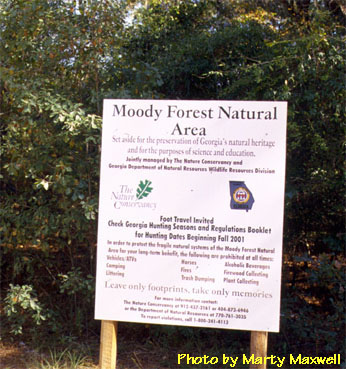 |
|||||||||||
| To learn more about the Moody Forest, click on this link: Preserving Upland Habitat: The Moody Forest Natural Area | |||||||||||
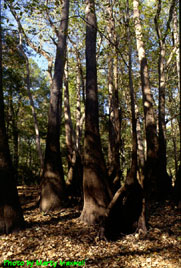 |
|||||||||||
|
Along the Altamaha River, sometimes the habitat adjacent to the river is a wetland, not dry upland. A wetland is a habitat that is sometimes partly covered with water. The predominant wetlands along the Altamaha River are cypress swamps. Swamps are low in elevation, not much higher than the river. Overflow from the river often floods swamp areas. As you walk through a swamp (when it is not too wet!) there is not much vegetation covering the ground. Rising above you are large cypress trees, often with Spanish moss hanging from their branches (see picture). Some of the cypress trees along the Altamaha River are over six hundred (600!) years old! Mixed among the cypress tress are some smaller trees, including water tupelo and red maple trees. Cypress trees are easy to identify because of their "knees" (see picture). Cypress trees have woody growths, called "knees," surrounding them. Knees are extensions of the cypress tree. They grow up from the tree's roots. Knees may grow to about a meter (3 feet) in height. |
|||||||||||
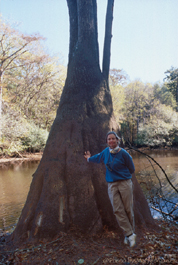 |
|||||||||||
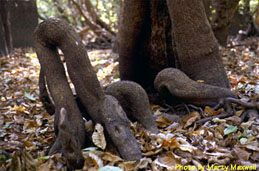 |
|||||||||||
| To see larger views of cypress knees and cypress trees, click on the pictures above and to the left. | |||||||||||